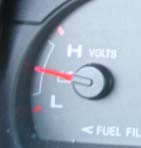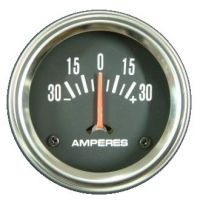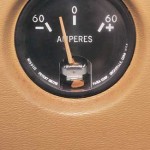Last night I found myself driving my car home in the pouring rain, splashing through puddles and wishing my windshield wipers had an “emergency overdrive” setting. A design flaw with my particular car causes any water splashed up by the right front tire to be sprayed directly onto the engine’s accessory drive belt. When this happens, the alternator pulley, which rides on the flat side of the belt, slips for a few moments until friction dries up the water. It’s an annoyance.

The gauges on my car’s instrument panel were designed for someone with the I.Q. of a toaster. In the diagnosis of an electrical system fault, the one gauge that’s been provided is so simplistic as to be completely useless. As you can see from the photo, it’s labeled “VOLTS.” Note, however, that there’s no scale at all. Without the ability to relate the needle position to an actual voltage, there’s no way to read this instrument in volts. This instrument measures arbitrary, unitless relative EMF.
Note the white and red markings. There’s a white range, which presumably represents normal voltage, and two red lines which we might guess represent the high and low voltage danger areas. From the space between the white range and the red markings, we can probably infer that voltages in those ranges are not normal, but also not dangerous.
How is this information useful? It isn’t. Without knowing the point on the gauge that represents the lead-acid battery’s float voltage, we can’t even know if we’re charging or discharging the battery. It might tell me that my voltage is “kind of low,” but  I don’t need a gauge for that. I pay attention. If my lights dim or my ventilation fan slows down, the voltage has dropped. The information I really want is WHY the voltage has dropped, and neither dimmed lights nor an arbitrary gauge will tell me that.
I must conclude that this gauge’s sole purpose is to mollify people who insist on having gauges instead of idiot lights, but who also have no idea how to read them.
This has led me to a question. What happened to the ammeters that cars used to have?

I know that question dates me. There’s probably not a single car on the market today that has an ammeter, so perhaps everyone’s forgotten what one looks like. An ammeter is an instrument that measures current, generally at a point between the battery and the voltage regulator. It has a pointer that rests at zero when no power is applied. When current is flowing toward the battery (charging), the pointer swings right. When current’s flowing the other way (discharging, as when the engine is stopped), the pointer swings left.
Unlike the silly, uncalibrated “voltmeter” in modern cars, this ammeter actually is a useful diagnostic tool. One glance at the ammeter, while driving, is enough to assess the health of the charging system. If the needle is centered or slightly right of center, all is well. If the needle swings left while you’re driving, you’ve lost your alternator (or its belt).
When the engine is idling, you can immediately tell if you’re discharging the battery by drawing more current than the alternator can supply at low speeds because the needle will tip left. You can then turn things off (shed load) to get the battery charging again.
Have you ever run your battery completely dead, perhaps by leaving the headlights on overnight? A jump start will get you going again, but you’ll need to drive the car for a while to recharge the battery. Â How do you know you’ve driven long enough? With a voltmeter, you guess. With an ammeter, you’ll immediately see a very large charging current right after the jump start. You need only drive until that charging current comes back down into the normal range.

Airplanes still have ammeters. The one at left is from a Cessna, and is showing about 30 amps of discharge, probably because the engine’s stopped and the landing lights are on for preflight inspection. I think some large trucks and certain pieces of industrial and farm equipment still have ammeters, too, but I haven’t seen one in a passenger car for many, many years. I’m really at a loss to explain why this is so.
Cost could be one explanation. Putting a voltmeter in the instrument panel (especially one that need not be accurate or even useful) is easy. Connect the positive side to any convenient spot in the electrical system, and the negative side to ground. Â Ammeters are a bit more complicated because they must be connected at a specific point, and because a shunt is needed to make them work. It certainly doesn’t seem like a costly thing to insert a simple shunt into the battery wire and run a two-conductor cable to the instrument panel. Â If a lawn tractor can be so equipped, why can’t a car be similarly outfitted?
If anyone has any insight as to the disappearance of this gauge from our dashboards, I’d love to hear it. I miss the ammeter.
Permalink
Cost is definitely a factor ad well as safety. You’re right, volt meters are easier to install, and wiring-wise, much cheaper. A 8 or 10 gauge wire is needed to go to the ammeter from the alternator, and back to the battery. This heavy capacity circuit is more dangerous in a accident, because it is seldom fused on both the alternator and battery end of the circuit. Fire probability is much greater with a high current capable circuit going through the firewall and under the dash. My 2 cents worth.
Permalink
True, Mike. However, a shunt ammeter wouldn’t require running high-current wiring through the firewall. That’s how it’s done in aircraft; the ammeter instrument is actually a center-zero voltmeter reading the voltage drop across a small shunt resistance in the battery circuit. That could easily be fused.
Permalink
It’s interesting I came across this discussion, since I’ve been meaning to install an ammeter.
How about a HALL current sensor? Wouldn’t that be a pretty safe way to measure current. Obviously, calibration/scaling/processing is the added cost/complexity, but you don’t even have to break the circuit anymore.
What do you guys think? Do you know of any reason why this wouldn’t work?
I’m starting to get ready to hack my own…
Permalink
Given a choice of having either an ammeter or a voltmeter, I would opt every time for the ammeter. Reason – it actually shows you whether the system is charging or not. Current discharge is indicative – and there are times when you need to know what current is being drawn. Yes it needs heavy gauge cabling yes it needs a quick blow fuse but connected correctly it will show if the alternator is charging or not, as discharge is always negative whilst charging is always positive and if the needle is slightly towards the positive side it shows the system is being trickle charged. Voltmeters do indicate the pressure of the system, but an ammeter shows how efficiently it is being transferred from the alternator to the battery or system. It is for that reason I would always opt for an ammeter. It is also for that reason that aircraft are fitted with both. Incidentally I have a battery that indicates it is fully charged with 13 V nominal but put a load on it and no current flows
Permalink
My Aston has one!
Permalink
Great discussion. As a former electrician in the Navy I agree that without an amp meter you have no way of knowing whether your alternator is actually charging your battery. I just left my accessory switch on the other day and ran the battery down. Had to charge if for a while so I could use the truck. Sure would have been nice to know when the alternator finished charging while I was driving. Also, you would get a pretty good idea when your battery is fading if your amp meter indicates that it has to continually charge. Looking for a solution now.
Permalink
I own a SMART FortTwo (MHD the European version) that has a Start-Stop system called Mycro-Hybrid-Drive by Mercedes-Benz. The stater engine is also the alternator and it is very heavy. The belt moves the alternator after a few thousands of kilometres, which finally breaks the belt and fries the engine. This is a known problem of European the Smart Fortwo made betwen 2007 and 2013. The American Smart ForTwo cars have not this problem, because they have no MHD (no start-stop system). A lot of people have not realised that the belt was broken and they have continued driving the car and overheating and killing the engine. The car has no coolant temperature gauge either. I have decided to install a coolant temperature gauge and an ammeter. Hopefully with the ammeter I will realised that the alternator has stoped working, stop the engine and the engine will not overheat. If I use very thick cables, should I worry about potential fires?
Permalink
The real reason why cars don’t have ammeters anymore, or at least virtually all, is expense. All traditional ammeters have a low resistance shunt that minimizes the affect of the meter itself on the current flow being measured, and a good shunt is costly. Since it’s cheaper to have a high resistance devise, the cars that have a battery gauge at all have a voltmeter which specifically has a high resistance to create minimal disturbance to the parameters being measured. And it’s cheaper yet to have a signal light that indicates total generator failure.
As to what a battery gauge will actually sow – an ammeter will show the net current flowing in or out of the battery – not the current between the battery and another point. A voltmeter will show the voltage across the battery terminals. Ideally, this will be 9 volts during engine starting, and 14 volts with the engine running with anywhere between 13 and 15 being acceptable. Below 13 means that the battery is draining, and eventually shifts into indicating how badly the battery is been drained, and more than 15 means that there’s one of 3 problems – the generator charging a low battery, the generator trying to charge a battery whose internal resistance is elevated due to old age and impending failure, or that the generator is overcharging the battery.
Most automotive voltmeters will read between 8 and 18 volts. Some will read between 9 and 17, some between 9 and 19. The pictured voltmeter from a Crown Victoria with an L mark, an H mark, and a “normal” range is actually indicating voltage in the range between 8 and 18 volts with anything between 10 and 17 volts being indicated as acceptable even though the acceptable range is actually 13 to 15.
Permalink
Interesting question. But. if you want an ammeter, you can make one as I have. I took a automotive grade -100A to +100A Hall Effect Current Sensor and an aftermarket Voltmeter from a company that would put a second scale on the gauge. The Voltmeter normally reads 0V to +18V(DC).
The added scale then reads -100A = 0v, 0A = 9V and +100A = 18V. A bunch of custom analog electronics between the Current Sensor and the Voltmeter completed the package. Note, there is no high current routed into the interior of the car, just a low voltage signal to drive the Voltmeter/Ammeter. Throw in a spdt toggle switch and you have BOTH an ammeter and a Voltmeter
Permalink
Sure ammeters are useful, but so are volt meters. A quick glance at the volt meter prior to starting your vehicle, then again after its idling, and again at higher engine speeds, can give pretty much the same indications of battery and charging system health and status.
Permalink
HÑ–! I could have sworn I’á´ e visited this websÑ–te befoï½’e
but after going through a few оf the posts I realizeÉ— it’s new to
me. Anyways, I’m definitely pleased I discovered it and I’ll be book-marking it and checking back
reɡularly!